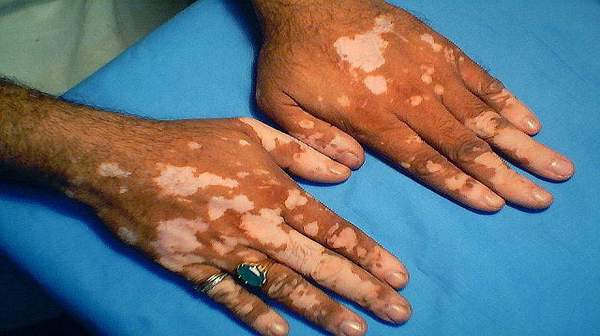What's in this article?
What Is Vitiligo?
Vitiligo (vit-ill-EYE-go) is a disorder in which white patches of skin appear on different parts of the body. This happens because the cells that make pigment (color) in the skin are destroyed. These cells are called melanocytes (ma-LAN-o-sites). Vitiligo can also affect the mucous membranes (such as the tissue inside the mouth and nose) and the eye.
Facts about Vitiligo
Vitiligo is a disease in which the pigment cells of the skin, melanocytes, are destroyed in certain areas.
- Vitiligo results in depigmented, or white, patches of skin in any location on the body.
- Vitiligo can be focal and localized to one area, or it may affect several different areas on the body.
- The exact cause of vitiligo is unknown, although most experts believe that it is an autoimmune condition in which the body’s immune system mistakenly attacks and destroys certain cells within the body.
- Most people who have vitiligo will develop the condition prior to age 40; about half develop it before age 20.
- Vitiligo tends to run in families.
- Vitiligo is sometimes associated with other medical conditions, includingthyroid dysfunction.
- Vitiligo is not painful and does not have significant health consequences; however, it can have emotional and psychological consequences.
- Some medical treatments can reduce the severity of the condition, but it can be difficult to cure.
Causes of Vitiligo
Melanin is the pigment that gives the skin its characteristic color. Vitiligo is caused by a loss of pigment in the skin, due to destruction of pigment-forming cells known as melanocytes. The exact cause of the destruction of these cells is not known. One possible explanation might be that the body’s immune system destroys the cells, as in other autoimmune conditions. Although vitiligo affects all races equally, it is more noticeable in dark-skinned people.
Symptoms of Vitiligo
The main sign of vitiligo is color (pigment) loss that produces light or white patches on your skin. Usually, the discoloration first shows on sun-exposed areas, such as the hands, feet, arms, face and lips.
Vitiligo signs include:
- Skin discoloration
- Premature whitening or graying of the hair on your scalp, eyelashes, eyebrows or beard (usually before age 35)
- Loss of color in the tissues that line the inside of your mouth and nose (mucous membranes)
- Loss of or change in color of the inner layer of the eyeball (retina)
- Discolored patches around the armpits, navel, genitals and rectum
Vitiligo can start at any age, but most often appears before age 20. Depending on the type of vitiligo you have, the discolored patches may cover:
- Many parts of your body. With this most common type, called generalized vitiligo, the discolored patches often progress similarly on corresponding body parts (symmetrically).
- Only one side or part of your body. This type, called segmental vitiligo, tends to occur at a younger age, progress for a year or two, then stop.
- One or only a few areas of your body. This type is called localized (focal) vitiligo.
It’s difficult to predict how your disease will progress. Sometimes the patches stop forming without treatment. In most cases, pigment loss spreads and eventually involves most of your skin. Rarely, the skin gets its color back.
Diagnosis and Treatment of Vitiligo
Your doctor can usually make the diagnosis of vitiligo during a physical exam. There is no known way to prevent or cure vitiligo. However, several methods, including cosmetics, re-pigmentation using UV light therapy, corticosteroid creams, depigmentation of unaffected skin areas, and skin grafting, can be used to improve the appearance of skin severely affected by vitiligo.





